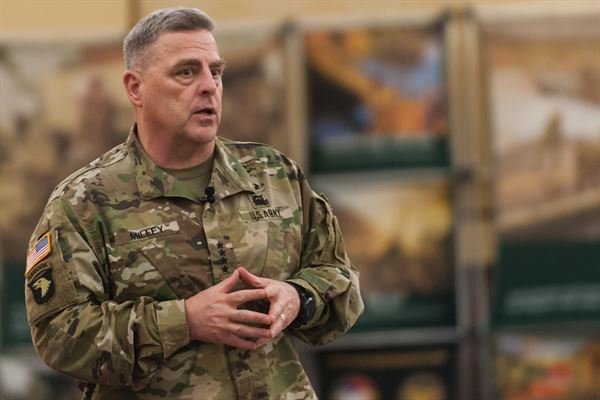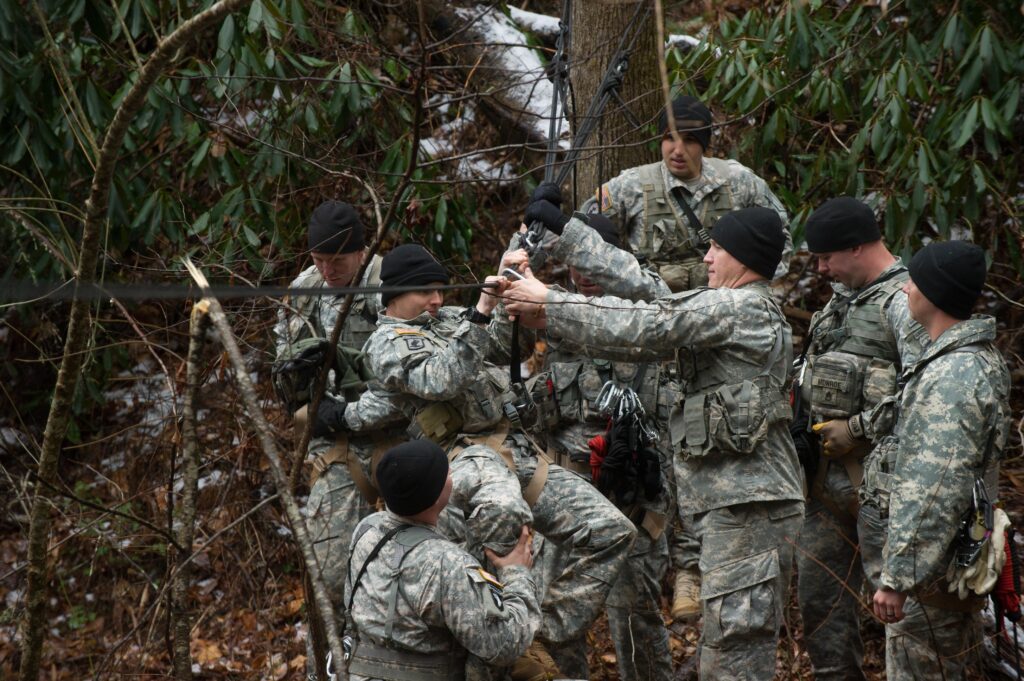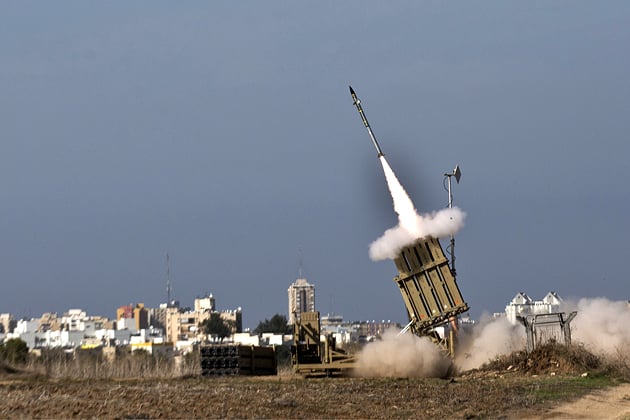Army Should Break With DoD’s Modernization Strategy [Sponsored]
Posted on

Gen. Mark Milley CSA
The Army needs to break with DoD’s modernization strategy or risk being broken itself. Simply stated, the Army cannot afford to cut end strength and units in order to free up resources for modernization. This is all the more true if the modernization programs are complex, expensive and will take years to reach IOC. The assessment of the global security environment undergirding DoD’s decision to emphasize capability over capacity is fundamentally at odds with reality.
Since the passage of the Budget Control Act of 2011 and the Defense Strategic Guidance of 2012, the Pentagon has been cutting the size of the military, retiring obsolescent weapons systems and reducing combat units in order to meet defense budget strictures while salvaging some prospect for modernizing the force. The Army felt the impact of this new strategy more than the other services. It cut 13 Brigade Combat Teams as part of the process of downsizing the Active Component end strength from a wartime high of 570,000 to a planned level of 450,000.
Of late, the pressure to reduce force structure and cut manpower has increased as DoD set itself on a course towards investing in advanced capabilities. As reflected in its so-called Third Offset Strategy, the Pentagon’s leadership believes the military has sufficient capacity or force levels to address today’s challenges, but needs to invest in new technologies in order to reassert its eroding advantage in cutting-edge military capabilities. This focus on capabilities vice capacity or number was reinforced by Defense Secretary Ash Carter’s recent directive to Navy Secretary Ray Mabus, in which he ordered that service to reduce its intended procurement of the Littoral Combat Ship and apply the savings to acquiring additional advanced tactical aircraft and munitions.
As the new Army Chief of Staff, Gen. Mark Milley observed in testimony before the Senate Armed Services Committee: “Right now the level of uncertainty, the velocity of instability, and potential for significant inter-state conflict is higher than it has been since the end of the Cold War in 1989-91.” It should be noted that at that time the size of the Active Component was in excess of 700,000 and the Total Force stood at more than 1.2 million.
It is increasingly evident that the Army is too small to meet even current challenges, much less the possibility for large-scale conflicts in multiple regions. In order to deal with two long-term stability operations in Southwest Asia, the Army had to grow temporarily to 570,000 in the Active Component. Even then, it actually conducted the two campaigns sequentially, not in parallel.
The National Commission on the Future of the Army concluded that the Army cannot meet its current missions at proposed force levels without a significant increase in resources above those mandated by the current budget compromise. Even then, there will be significant capability shortfalls in terms of both manpower and technologies. The commission even goes so far as to suggest the possible need for a further reduction of two combat brigades in order to free up manpower for support missions. In the words of Nadia Schawlow, a well-respected expert on Army issues: “the commission pulled its punches on Army end strength. It endorses a minimum level of manpower, while admitting existing rotational policies actually leave the active duty force understrength in the event of simultaneous contingencies.”

Army troops build rope bridge
The reality for the Army is that numbers count and it is extremely difficult to replace the power of soldiers on the ground with machines in any form. Unlike air and naval combat, which involve clashes between a relatively small number of high performance machines, land warfare is about numbers. It is ironic that the military services and Pentagon leadership continually say that people are its critical military advantage while cutting personnel so they can acquire more hardware.
It is clear that even an enhanced Active Component will not be sufficient to address all major missions. At a minimum, the Active Component must possess both the capacity and capability to ensure that no adversary can achieve a successful “blitzkrieg.” The role of the National Guard in such a scenario is to make it clear to an adversary that the U.S. military has sufficient capacity to pursue a protracted conflict, if necessary. To fulfill this role the National Guard does not need to be a carbon copy of the Active Component. But it does have to be robust, with combat units capable of taking their place in the line of battle or supporting a counterattack.
Avoiding the continual erosion of its end strength is only the first problem the Army faces. It must also invest in essential modernization. But how to do so without breaking the bank or, at least, provoking yet another round of personnel cuts to create an investment fund?
The answer is to break with past service and DoD practices with respect to modernization. Over the past two decades, Army modernization has careened from one fanciful idea to another, generally reflecting the Pentagon’s changing views of the national security environment and the prospects for future conflict. Across all the various ideas – Comanche, Future Combat System, Ground Combat Vehicle – Army modernization focused on the wrong problem. It sought to replicate the other services, building ever more exquisite machines embedded in ever more elaborate networks that required fewer people and permitted increased distance between the soldier and the target. It was predictable that each of these efforts would be extremely complex, very expensive and take way too long to reach the field.
In order to both increase end strength and pursue a course of modernization, the Army needs to change how it formulates requirements and pursues acquisitions. In particular, the Army needs to institutionalize the practice of the recent conflicts of allowing commanders in the field to drive the processes through the generation of operational needs statements. This reflects the experiences of the past decade in which hundreds of items were procured, everything from cold weather gear to robots, unmanned systems, aerostats, sensors and armored vehicles, through an accelerated acquisition process based on operational requirements generated in the field. Current examples: ultralight vehicles, Mobile Protected Firepower vehicle, 30mm cannon for Stryker and the Advanced Precision Kill Weapon System.

Israeli Iron Dome launch
This approach will not work for everything, most notably major new weapons systems and combat vehicles. But it is particularly relevant and useful at this stage in the Army’s evolution where there is little money for new starts, transformational technologies are fairly far out on the horizon and there is substantial uncertainty regarding where the Army will be deployed and how it will be required to fight. By focusing on the operational needs generated by field commanders the Army can promote relevance, shorten acquisition timelines, constrain system costs, limit the potential for mischief by a distant acquisition bureaucracy and, perhaps most important, get new capabilities in the hands of operators rapidly.
In short, instead of tying up large blocks of resources for protracted periods of time while developing exquisite systems, the Army needs to focus on low-cost, rapidly producible and deployable capabilities. Where possible, the Army should rely on non-developmental items — including those developed by allies. For example, Israeli defense industries have fielded the highly successful Iron Dome system to counter rockets, missiles, artillery and mortars and the Trophy Active Protection System to defeat anti-tank rockets and missiles. In areas such as communications and IT, the Army needs to leverage wherever possible the commercial world rather than pursue purpose-built capabilities that come with high price tags and long timelines.
This approach will result in a Total Force characterized by tiered modernization. Central to this approach is the return of the National Guard to its erstwhile role as a Strategic Reserve. High-end capabilities that require extensive training and maintenance must reside largely, perhaps even exclusively, in the Active Component. It will take time to organize, equip, train and deploy Reserve Component formations. There may be time to provide these units with supplementary capabilities based on feedback from field commanders.
With tiered modernization in mind, the National Commission erred in proposing that four Apache battalions be retained in the Reserve Component. A more sensible solution would have been to replace the Apache helicopters with additional Black Hawks, but develop an appropriate light attack capability for them.
The key to managing a force based on tiered readiness will be found in its networking and Command and Control. Senior Army leaders have stressed the importance of end-to-end connectivity and the ability to integrate the variety of capabilities resident in the Joint Force. As the TO&E of the Total Force becomes more heterogeneous, it will be vital that it is held together by a solid communications backbone. Consequently, investments in IT, networking, sensors and ISR will be more important than the introduction of new platforms.
For too long the Army has been asked to reduce capacity in the interest of maintaining readiness and modernization. The increasingly complex and unstable international security environment is creating a new demand on the Army to field forces, not just at prior to or at the start of a conflict but form the long haul. If the Army is to retain or even increase its capacity, it must be very careful in the way it pursues modernization. It also must be willing to modernize selectively, at a minimum cost and with a primary focus on the Active Component.
Subscribe to our newsletter
Promotions, new products and sales. Directly to your inbox.
